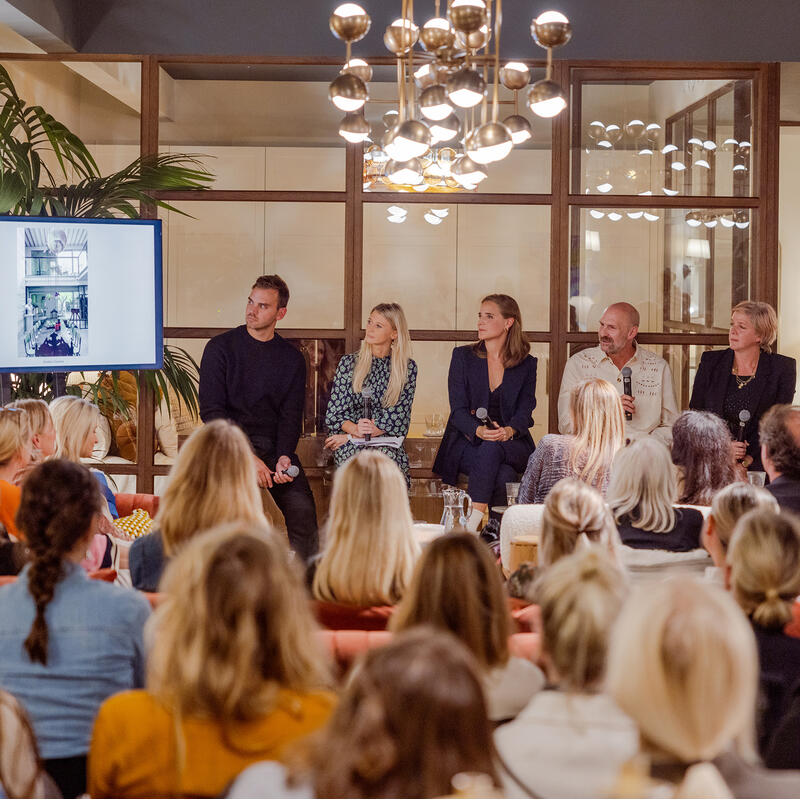By Megan Murray
Last month, we were so excited to welcome an impressive panel of interior designers to Soho.Home.Studio Westbourne Grove for our first Soho Home Trade event.
Joining us in our newest London space was Scott Maddux and Jo Le Gleud of Maddux Creative, Beata Heuman, and Camilla Clarke and Ben Johnson from Albion Nord, led by the style director of The World of Interiors, Gianluca Longo.
The event was to celebrate our Soho Home Trade network, bringing together some of the best in the business to connect and, in this instance, discuss the interplay between old and new in design.
Here, we pick out some of our favourite themes from the evening's discussion, looking at how and why we should be bringing a sense of eclecticism using vintage and antique pieces mixed with modern design. We hope you'll join us at our next event - see below for what you missed this time.


What comes first: old or new?
'We always mix old and new, in every project, whether it's contemporary or traditional,' says Clarke of Albion Nord. 'We generally know what we're looking for, rather than stumbling on a vintage piece and letting that dictate the space. So, we will have a mood or loose brief of maybe a Danish mid-century desk, and then we hunt for something and react in the moment to shape, size, and colour.'
Maddux Creative, however, shares how new can inform the old, as they often utilise modern pieces and techniques to empower traditional features to shine brighter. 'An old property we worked on in Notting Hill had these huge, rounded bays with large period windows in almost every room and that was quite a challenge. To lean into this feature, we commissioned a new sofa with sleek lines, which curved into the space and mimicked it,' explains Maddux.
'In a period apartment in Marylebone, we gave depth and intimacy to a large, high ceiling space with a wall mural that stretched across the whole room, using tonal colours in a modular way,' adds Le Gleud. Indeed, while the squares of colour look contemporary next to the intricate panelling, the sharp angles are softened with pale pastel colours that fade into one another.


The benefit of bringing in pieces from different eras
'I think mixing old and new like this is vital, because it allows us all to be lots of different things at the same time, which is important,' shares Heuman. 'I agree,' adds Le Gleud. 'It allows you to tell the story of the people living in the house, and they are made of many things.'
The other half of Maddux Creative, Scott, shares his technique for using vintage shopping to delve into a client's personality. 'A powerful way to get an insight into what makes a person tick is to go shopping with them to antiques fairs. I do this as early as I can and spend two days just looking at things,' he says. 'When you see their eyes light up as they look at something they never knew they needed, it's like boom - instant information.'
'Weaving in old with new can also set a tone for a sense of eclecticism which, as Johnson of Albion Nord says, makes way for the home's interiors to keep growing and changing after you have gone. 'When a scheme is all one style or all contemporary - well, one, it's soulless. But, two, it's very different to change or adapt that. As your taste develops it allows you to grow with your home - that's the benefit.'


Bringing soul to a new-build property
'In a contemporary space the aim is to create warmth, soul and character in what, in some cases, has essentially been a white box. In a small flat in west London, we used green fabric panelled walls to add texture and bring the outside in,' says Clarke.
When also faced with a 'white box', Heuman brought warmth to a U-shaped new build in Germany. 'The client wanted traditional detailing, but it took hours to convince her to let go of this dream of cornicing, because it wouldn't have suited the ceiling heights. Instead, you can use texture and colour to bring character.
'A lot of modern buildings have open-plan spaces, which I like to play with by creating off-shoots of different areas. I think in design you want the eye to travel and to invite people to explore the space. Giving an open-plan room different element does this, and creates mystery and intrigue.'
Our Soho Home Trade network is here to support designers, architects and stylists across the interiors industry. Click here to learn more about the benefits and how to join, so you can be invited to future exclusive Trade events.


